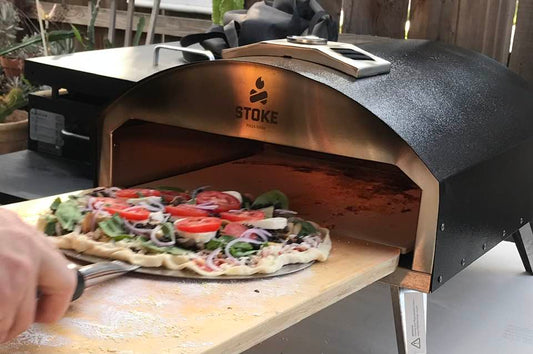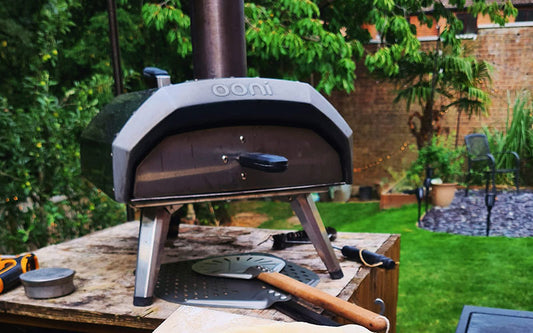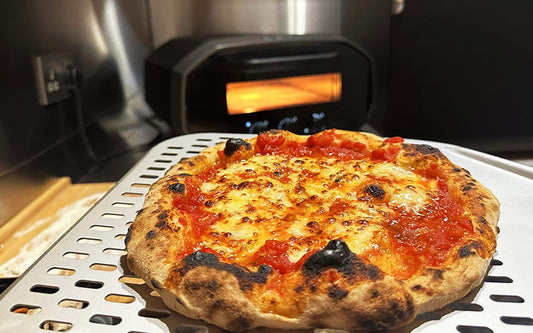The debate between pizza steel and stone is a hotly contested one. Both have their merits, but which one should you choose? Well, it depends on a couple of factors.
Pizza steel, as the name suggests, is usually made from carbon steel. It’s a thin metal plate that heats up quickly and evenly, which makes it perfect for making crispy, charred crusts. On the other hand, a pizza stone is made from either ceramic or cordierite. It takes longer to heat up than a steel plate does.
As someone who has used both apparatuses, I can tell you that neither is better or worse than the other. Pizza steel has a much better heat retention ability than steel. It is easier to clean due to its non-porous surface. Pizza stones are a better fit for brick ovens and portable outdoor ovens like Ooni because they help stabilize the temperature in the oven.
Also, stones take a longer time to transfer energy. This results in a crunchier crust as opposed to the fluffy texture of pizzas cooked on a steel.
At the end of the day, it all comes down to the kind of crust you’re after and the sort of oven you are using. Keep reading to find out how.
What Is a Pizza Steel and Why Do You Need One?
Pizza steel is a flat, rectangular metal slab that is designed for use in the oven or on the grill to bake pizzas. It is made of high-quality steel that is able to conduct heat efficiently and evenly. A36 carbon steel plates are the most commonly used material for pizza steel because of their high conductivity.

One of the main benefits of using a pizza steel is its fantastic heat retention ability. Because it is made of steel, it is able to hold onto the heat from the oven or grill for an extended period of time, which allows it to cook the pizza evenly from the bottom up.
It also heats up rapidly, allowing you to cook multiple pizzas in a short amount of time.
Here’s a quick summary of the pros and cons of using pizza steel:
Pros
- As you may already know, steel is a better conductor of heat than stone. So steel will heat up much more quickly and retain the heat for an extended period, resulting in a crispier crust. For its excellent heat retention ability, I found pizza steels to be a better choice for baking pizzas in a convection oven.
- The high thermal conductivity results in a shorter cooking time. If you want to be able to make multiple pizzas in a short amount of time using your regular oven, pizza steel is a better choice. The short cooking time will also help you save on energy costs.
- Pizza steels are also very easy to clean. They have a smooth surface that makes it easy to wipe away any unwanted food particles or grease with just a damp cloth.
- Unlike stones, pizza steels don’t crack. They typically last much longer than a standard pizza stone.
Cons
What Is a Pizza Stone and Why Should You Consider Getting One?
A pizza stone is an unglazed ceramic tile that is used to make pizza. It is placed in the oven and heated up before you bake the pizza on top of it. The porous nature of the stone absorbs moisture from your dough, which helps give you a crispy crust.
Some stones are made of cordierite and composite materials as well. These stones typically last longer than ceramic pizza stones.
Next Read: Why a thick pizza stone is essential for the perfect crust.
So why use a pizza stone when a steel is perfectly capable of making a great pizza? Well, there are several reasons.
Pros
- Pizza stones take longer to transfer heat from the surface to the pizza base, which means it takes slightly longer to bake, resulting in a fluffier crust. That’s why Neapolitan-style pizzas are mostly baked on a stone rather than on a pizza steel.
- A pizza stone can distribute the heat more evenly inside the oven, which would help you stabilize the temperature. A lot of people leave the stone in the oven all the time to avoid hot and cold spots.
- Using a stone will give you more control over how browned or charred your crust gets, thanks to its uniform heat distribution.
- High heat and hot stone surface create a unique and sublime smoky flavor that a pizza steel or cast iron pizza pan cannot replicate.
- It’s usually cheaper than pizza steels.
Cons
- The biggest downside of using a pizza stone is that it takes longer to heat up. It can take an hour or more for your oven’s temperature to stabilize after you put the stone in it, which means your pizzas will come out slightly underdone if you don’t wait long enough before baking them on top of the hot stone.
- It’s a porous surface, which means you can wash it down with soapy water. It can also absorb flavors from the other foods you cook on it, which may affect the taste of your pizza if you’re using a flavored stone. You will have to scrape the burnt bits off after every use and flip it upside down, letting the fire sanitize the cooking surface.
- Pizza stones are prone to cracking. To prolong the lifespan of your stone, avoid putting a cold stone in a hot oven, handle it gently, and allow the stone to cool down before taking it out of the oven after baking.
Pizza Steel vs Stone: Key Differences
The two materials have similar properties and can be used interchangeably in many cases. However, there are some key differences you should keep in mind when deciding between a pizza steel and a pizza stone:
| Pizza Steel | Pizza Stone |
|---|---|
| Heats up faster | Takes longer to heat up |
| More expensive | Less expensive |
| It can handle higher temperatures. | Can crack at high temperatures |
| Heavy and difficult to handle. | Lightweight and easy to handle |
| Cause pizzas to stick | Pizzas are less likely to stick |
| Retains heat longer | Loses heat faster |
| Difficult to clean | Easy to clean |
Materials
The steel used in pizza steel is usually a type of high-carbon steel (A36 steel plate, to be more specific), which is able to retain heat for an extended period of time and distribute it evenly across the surface of the steel.
This makes it ideal for baking pizzas, as it allows the pizza to cook evenly from the bottom up, resulting in a light and crunchy crust. The thickness of the steel can also impact its cooking ability, with thicker steel being able to retain more heat and cook the pizza more evenly.
Next Read: Experience the Best Pizza of Your Life with a Cast Iron Pan
Pizza stones, on the other hand, are typically made of ceramic, cordierite, or composite material. These materials are able to conduct heat efficiently and evenly, which makes them ideal for baking at a lower temperature.
If you are aiming for an airy, puffy pizza crust with beautiful charring spots, a pizza stone might be a better option.
The thermal mass also has a heat-stabilizing effect, meaning the stone is able to maintain an even temperature for longer periods of time in cheaper ovens.
Heat Conductivity
Steel is a better conductor of heat than stone which means it will heat up faster than either a pizza stone or a ceramic pizza pan. Shorter heat-up and baking time are a big advantage when you’re baking multiple pizzas back to back.
Stones take about an hour or sometimes longer to heat up. So, if we are comparing the two strictly on the basis of thermal conductivity, steel is a clear winner.
Preheating and Cooking Time
Both pizza stones and steels require preheating. The difference between the two is that a pizza steel can be preheated in the oven at high heat for about 45 minutes and then immediately used for baking, whereas stone requires an hour or more to reach its optimal temperature.
In a domestic oven, a pizza steel takes about 5-8 minutes to bake a pizza, whereas a stone can take 10-12 minutes in a preheated oven. If you want a crispier crust, aim for a shorter cooking time, and for a thicker, chewier crust, a slightly longer cooking time is ideal.
Versatility
Thanks to its fast cooking time, pizza steels are a great equipment for making fast-cooking flatbreads like naan, pita, and even calzones and cookies.
Pizza stones, in my opinion, scores slightly higher in the versatility department. From steaks, fish, roasted veggies, or different types of breads like sourdough, focaccia, baguette, and even cakes – a stone can do it all. You can cook low and slow on a hot stone surface, a quality that eludes pizza steels.
Durability
Both pizza steel and pizza stone are durable materials that can withstand high temperatures and prolonged use. However, there are some differences that can make or break the deal.
One of the main differences between pizza steel and pizza stone is their resistance to cracking and breaking. Pizza steel is generally more resistant to cracking and breaking than pizza stone, due to its superior strength and durability.
This means that it is less likely to break or crack under the high heat of the oven or grill, and it is more likely to last for an extended period of time.
Next Read: Deliver the Best Pizza in Town with Insulated and Durable Delivery Bag
The second difference between the two materials is their ability to withstand thermal shock. Thermal shock refers to the rapid change in temperature that can occur when a material is exposed to extreme heat or cold.
Pizza steel is way more resistant to thermal shock than a pizza stone. So, it won’t crack, unlike pizza stones, after extended usage.
In short, in the matter of durability, pizza steel is the clear winner. In fact, you can use it for a lifetime without needing to replace it.
Maintenance
Pizza steel is much easier to maintain than a pizza stone. You can simply wipe it down with a damp cloth and leave it to dry in the open air. Alternatively, you can wash it in warm soapy water and dry it afterwards.
Stone is a porous material, which means you cannot clean up the burnt bits and grease with soapy water. Instead, you will have to scrape off the gunk with an oven brush or spatula after every use.
And once in a while, you will have to flip it upside down, exposing the cleaner side and allowing the oven heat to burn down all the dirt on the other side.
It’s not really that difficult, but I prefer being able to thoroughly wash my cooking surface.
How to Use a Pizza Steel and Pizza Stone?
Here is a step-by-step guide on how to use a pizza steel for baking pizza:
- Preheat the oven to the highest temperature possible (usually around 550 degrees Fahrenheit).
- Preheat the pizza steel in the oven for at least 45 minutes to an hour.
- Prepare your pizza dough and toppings.
- Dust your pizza steel with cornmeal or semolina flour to prevent the dough from sticking.
- Stretch the dough into your desired shape and place it on the pizza steel; add your desired toppings.
- Bake the pizza until the crust is golden brown and the cheese is melted and bubbly. It should take about 5-8 minutes, depending on the dough and your oven.
The steps are pretty much the same for pizza stones. The only real difference is you will have to let it preheat in the oven for a full hour or even longer if you’re using an outdoor oven and the weather outside is cold.
Related FAQs
Is it better to cook pizza on a stone or cast iron?
If you are just starting out your pizza-baking journey, I’d recommend cast iron. It’s much easier to handle and clean.
A pizza stone will give you a lighter, puffier, and more evenly browned crust, while a cast iron will result in a crispier crust. At the end of the day, it boils down to your personal preference.
Do pizza stones make pizza taste better?
Yes, I believe. That’s probably because the stone is a porous surface, so it absorbs flavors from the dishes that get cooked on it. The older your pizza stone is, the tastier your pizza will be.
Will a frozen pizza crack a pizza stone?
You shouldn’t, as it can cause thermal shock. This means that the pizza stone can crack and break if you put a frozen pizza on top a smoldering hot stone.
Instead, thaw your pizza in the fridge or at room temperature. You can then slide it onto your stone once it’s ready to cook.
In Conclusion – Should You Get a Pizza Stone or a Pizza Steel?
If you’re looking for a more authentic pizza experience, then a pizza stone is the way to go. It’ll give you that light, puffy, and crispy crust that you usually get from quality pizzerias. If you’re looking for something that’s easy to use and clean up after, then consider getting pizza steel instead.
When it comes to heat retention, pizza steel is a clear winner. The steel will also give you a more evenly cooked pizza. It’ll heat up quickly and retain that heat for a long time.




